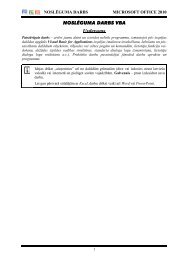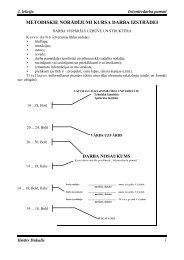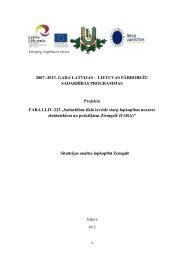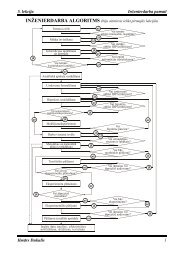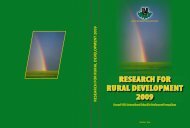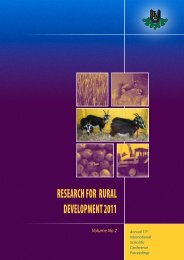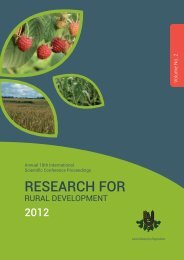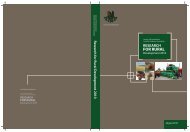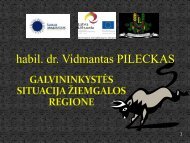LATVIA UNIVERSITY OF AGRICULTURE - Latvijas ...
LATVIA UNIVERSITY OF AGRICULTURE - Latvijas ...
LATVIA UNIVERSITY OF AGRICULTURE - Latvijas ...
- No tags were found...
You also want an ePaper? Increase the reach of your titles
YUMPU automatically turns print PDFs into web optimized ePapers that Google loves.
AGRICULTURAL SCIENCES (CROP SCIENCES, ANIMAL SCIENCES)IMPACT <strong>OF</strong> HARVEST TIMING AND CULTIVAR ON BIOGAS OUTCOMEFROM WINTER WHEAT SILAGEInga Jansone 1,2 , Zinta Gaile 11Latvia University of Agriculture2State Stende Cereals Breeding Institute, Latviae-mail: Inga.jansone@e-apollo.lvAbstractBiogas can be produced from industrial by-products, household waste and raw materials of agricultural origin.Agricultural resources can be agricultural by-products, for example, manure as well as biomass of energy crops.The objective of the trial was to evaluate the methane outcome from the winter wheat (Triticum aestivum L.) silagedepending on the variety and the growth stage during the harvest. The trial was carried out in State Stende CerealsBreeding Institute in the autumn of 2009. The biomass of three varieties of winter wheat, harvested at three stagesof maturity - at the beginning of flowering (GS 60-62), early milk ripeness (GS 70-72), and early yellow ripeness(GS 80-82) - was ensiled in laboratory conditions. The silage was analysed 180 days after it had been ensiled. Thebiogas and methane outcome in laboratory conditions (in Germany) was determined for samples of silage made fromwinter wheat variety ‘Skalmeje’ at all harvesting times according to VDI 4630 method. The theoretically obtainablemethane outcome was calculated for silage samples of all varieties by using the results of chemical compositionanalysis (crude protein, crude fibre, crude fat, N-free-extracts). The highest methane outcome from one ton of winterwheat silage was acquired by harvesting and ensiling the biomass during the flowering stage. However, evaluatingthe methane yield from one hectare, the best results were obtained by harvesting and ensiling the biomass at the earlymilk stage of ripeness and at the stage of early yellow ripeness.Key words: winter wheat silage, growth stages, cultivars, chemical composition, methane outcome.IntroductionEnergy security or the ability to ensure thenecessary energy resources is one of the prioritiesin the European Union. Latvia can currently ensureslightly less than one third of the necessary energyby using the local energy resources. The trials haveto be carried out in the local conditions of Latvia inorder to establish effective methods for using biomassin creation of new alternative types of fuel that couldfully or partially substitute fossil fuels. In recentyears Latvia has experienced a rapid increase in theconstruction of biogas factories. However, there is aproblem of raw material availability. Biogas can beproduced from different raw materials, including frommaterials of agricultural origin. The raw materials fromagricultural sector can be agricultural by-productsas well as energy crops (crops with high biomassyield). In Latvia similarly to the trend in Europethere is a willingness to use mostly maize (Zea maysL.) for the production of biogas, but it is importantto cultivate different energy crops in order to ensurethe crop diversity in the farms and to reduce the riskfor the biogas producers in periods when the maizeharvests are poor. Austrian scientists confirm that thesustainable biogas production from energy crops is notensured by maximal yields of one species, but from asustainable and environmentally friendly crop rotationsystem (Bauer et al., 2007). Winter wheat (Triticumaestivum L.) can also be included in the crop rotationas the winter wheat silage could be used for biogasproduction. Winter wheat is a suitable cereal cropfor the conditions of Latvia because the cultivationtechnology is well-developed and the producers haveaccumulated a great amount of experience.The task of the trial was to evaluate the methaneoutcome from the winter wheat silage depending onthe variety and the stage of maturity during the harvest.Materials and MethodsThe trial was carried out in State Stende CerealsBreeding Institute in the autumn of 2009 in the sodpodzolicloam soil that had following characteristics:pH KCl 5.6-6.0, content of organic matter - 24 g kg -1 ,content of available for plants P - 100 mg kg -1 , andthat of K – 150 mg kg -1 . Three winter wheat varieties– ‘Mulan’, line ‘99-115’, and ‘Skalmeje’ – wereexamined during the trial. The biomass of cereals washarvested during three growth stages: at the beginningof flowering (GS 60-62), early milk ripeness (GS 70-72), and early yellow ripeness (GS 80-82). Winterwheat biomass was harvested by manual mower,each time determining the weight of the green masson the field by using the scales ACCULAB SV–30with the accuracy of 0.005 kg. An average samplewas taken from all four replicates in order to make asilage and analysis. The silage was analysed 180 daysafter ensiling. The content of dry matter (DM) (LVSISO 712 – 2003) and ash (XY) (ISO 5984:1978),g kg -1 , was determined and these results were used tocalculate the content of organic dry matter (ODM),g kg -1 . During the analysis of silage samples, thecontent of (1) crude protein (XP), g kg -1 (LVS ENISO 5983-2:2009), (2) crude fibre (XF), g kg -1(ISO 5498:1981), and (3) crude fat (XT), g kg -118 Research for Rural Development 2012



